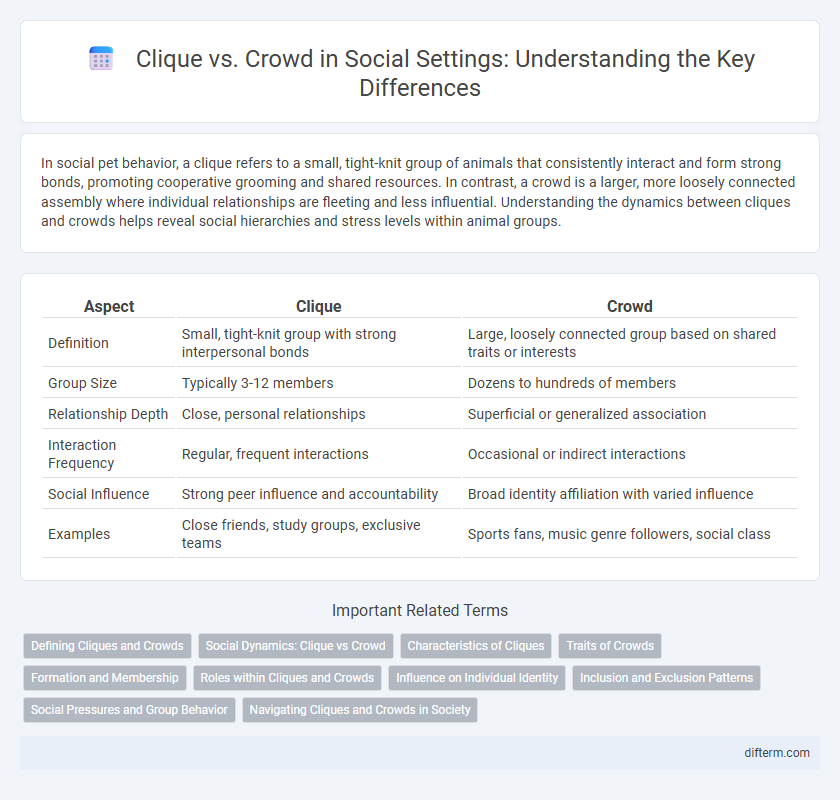In social pet behavior, a clique refers to a small, tight-knit group of animals that consistently interact and form strong bonds, promoting cooperative grooming and shared resources. In contrast, a crowd is a larger, more loosely connected assembly where individual relationships are fleeting and less influential. Understanding the dynamics between cliques and crowds helps reveal social hierarchies and stress levels within animal groups.
Table of Comparison
| Aspect | Clique | Crowd |
|---|---|---|
| Definition | Small, tight-knit group with strong interpersonal bonds | Large, loosely connected group based on shared traits or interests |
| Group Size | Typically 3-12 members | Dozens to hundreds of members |
| Relationship Depth | Close, personal relationships | Superficial or generalized association |
| Interaction Frequency | Regular, frequent interactions | Occasional or indirect interactions |
| Social Influence | Strong peer influence and accountability | Broad identity affiliation with varied influence |
| Examples | Close friends, study groups, exclusive teams | Sports fans, music genre followers, social class |
Defining Cliques and Crowds
Cliques are small, tightly-knit groups of individuals who share close, personal bonds and often have similar interests or backgrounds, creating a strong sense of identity and exclusivity. Crowds are larger, more loosely connected groups characterized by shared reputations, behaviors, or lifestyles rather than intimate relationships, often influencing social standing within a broader community. Understanding the distinctions between cliques and crowds is essential for analyzing social dynamics and peer influence in various social settings.
Social Dynamics: Clique vs Crowd
Cliques are small, tightly knit groups characterized by strong social bonds and exclusivity, often influencing members' behaviors and identities more intensely. Crowds represent larger, loosely organized social groups that provide broader social identities based on shared interests or reputations rather than close personal ties. The dynamics between cliques and crowds shape social hierarchies and impact individuals' sense of belonging and social influence within a community.
Characteristics of Cliques
Cliques are small social groups characterized by strong, exclusive bonds and frequent face-to-face interactions, often formed around shared interests or values. Members of cliques tend to exhibit high loyalty, mutual support, and conformity to group norms, which fosters a sense of identity and belonging. These groups typically maintain clear boundaries, limiting outside access and reinforcing social cohesion and identity among members.
Traits of Crowds
Crowds exhibit collective behavior characterized by emotional intensity, anonymity, and suggestibility, often leading individuals to act differently than they would alone. They tend to prioritize immediate goals and are influenced by shared emotions rather than logical reasoning. This results in rapid opinion shifts and heightened conformity within the group.
Formation and Membership
Cliques form through close-knit, selective friendships characterized by frequent interaction and shared interests, often lasting over long periods. Membership in a clique is exclusive, with members typically reinforcing group norms and exhibiting loyalty. Crowds emerge based on reputations or shared identities within larger social settings, allowing flexible, open membership and less intimate connections among individuals.
Roles within Cliques and Crowds
Roles within cliques typically involve close-knit friendships where members share mutual trust and support, often leading to a strong sense of identity and loyalty. Crowds, in contrast, are larger social groups defined by shared interests or reputations rather than close personal ties, with members occupying more generalized roles such as leaders, followers, or outsiders. Understanding these distinctions helps clarify how social dynamics and peer influence operate in adolescent and social development contexts.
Influence on Individual Identity
Cliques exert strong, exclusive influence on individual identity by promoting conformity to shared values, behaviors, and norms within a tight-knit group, intensifying peer pressure and social validation. Crowds, composed of larger, more diverse social groups, influence identity through broader social categories and stereotypes, offering individuals a sense of belonging based on common interests or reputations rather than intimate connections. The nuanced dynamics between cliques and crowds shape self-concept by balancing the desire for uniqueness with the need for social acceptance.
Inclusion and Exclusion Patterns
Cliques often create rigid inclusion and exclusion patterns by forming tightly-knit groups that limit membership based on shared interests or social status, reinforcing exclusivity. Crowds, being larger and more loosely organized, allow for more fluid social interactions and broader inclusion, accommodating diverse individuals under a common identity. These dynamics influence social cohesion by shaping how individuals navigate acceptance and rejection within social environments.
Social Pressures and Group Behavior
Cliques exert intense social pressures by promoting conformity, exclusivity, and rigid group norms that influence individual behavior through fear of rejection or exclusion. In contrast, crowds represent larger, more fluid social groups where individuals experience looser social influences, often shaping behavior through shared interests or identities rather than strict conformity. Understanding these dynamics highlights how clique membership intensifies peer pressure, while crowd affiliation allows for more diverse expressions of social identity.
Navigating Cliques and Crowds in Society
Navigating cliques and crowds in society requires understanding their distinct social dynamics, where cliques consist of small, close-knit groups with exclusive membership, while crowds represent larger, more loosely connected assemblies sharing common interests or identities. Effective social navigation involves developing interpersonal skills to engage inclusively with diverse groups, recognizing underlying social hierarchies, and balancing conformity with authenticity. Mastering this balance enhances social cohesion, reduces isolation, and fosters a supportive community environment.
Clique vs Crowd Infographic

 difterm.com
difterm.com